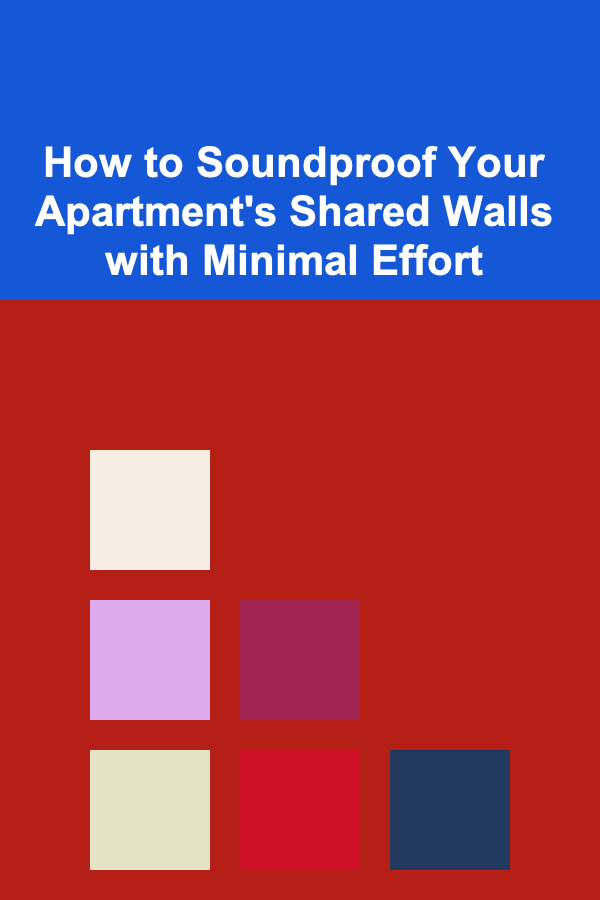
How to Soundproof Your Apartment's Shared Walls with Minimal Effort
ebook include PDF & Audio bundle (Micro Guide)
$12.99$9.99
Limited Time Offer! Order within the next:

Living in an apartment can offer the conveniences of proximity to work, entertainment, and social activities, but it also comes with its own set of challenges---chief among them being noise. One of the most common and frustrating sources of disturbance in apartment living is noise from neighbors, especially when it comes through shared walls. Whether it's the sounds of footsteps, conversations, loud music, or the TV blaring late into the night, these noises can make it hard to relax, sleep, or focus in your own space.
While soundproofing an apartment might seem like an expensive, complicated process that requires major construction work, there are plenty of simple, low-cost solutions that can help reduce the impact of noise coming through shared walls. In this article, we'll explore various methods and techniques that can soundproof your apartment's shared walls with minimal effort and investment.
Understanding the Importance of Soundproofing
Before diving into specific soundproofing techniques, it's important to understand why soundproofing matters and why shared walls are particularly susceptible to noise transmission.
In an apartment, the walls that separate you from your neighbors act as barriers that either absorb or transmit sound. The effectiveness of these walls in blocking noise depends on several factors, including the materials used in construction, the thickness of the walls, and any gaps or openings between the walls and the floor or ceiling.
Noises can be categorized into two main types:
- Airborne Sound: This is the sound that travels through the air, such as conversations, music, or the sound of a TV.
- Impact Sound: This type of noise results from physical impacts, like footsteps, objects being dropped, or furniture being moved.
Both types of sound can travel through walls, floors, and ceilings, which is why soundproofing shared walls is crucial to creating a peaceful living environment.
How to Soundproof Shared Walls with Minimal Effort
Soundproofing shared walls doesn't always require extensive renovations or expensive equipment. In fact, there are a variety of simple, cost-effective techniques that you can implement to reduce the amount of noise coming through the walls. Below are some of the most effective methods to soundproof your apartment with minimal effort.
1. Seal Gaps and Cracks
One of the easiest and most effective ways to reduce noise transfer is by sealing gaps and cracks in the walls. Even the smallest of gaps can allow sound to pass through, especially in older buildings where walls may have developed small fissures over time.
- Where to Look: Check around electrical outlets, light switches, baseboards, and window frames. These are common areas where gaps can develop.
- What You'll Need: Acoustic caulk or weatherstripping is ideal for sealing these gaps. Unlike regular caulk, acoustic caulk is specifically designed to reduce sound transmission.
- How to Apply: Simply apply the caulk along the edges of any gaps, then smooth it out with a damp cloth. For larger gaps, consider using foam backer rods along with caulk for a better seal.
By addressing these small gaps, you'll significantly reduce both airborne and impact sound from seeping through the walls.
2. Hang Acoustic Panels or Foam Tiles
Acoustic panels and foam tiles are designed to absorb sound waves and reduce the echo within a room. By installing these on the walls, you can improve the acoustics of your space and minimize the amount of noise that travels through shared walls.
- Where to Place: The most effective places to install these panels are on the walls that share a boundary with noisy neighbors. You can cover the entire wall or place panels in areas that are most prone to sound transmission, such as near windows or doors.
- How to Install: Many acoustic panels and foam tiles come with adhesive backing, making them easy to stick to the wall without the need for drilling or damaging the surface. If you're renting and want a non-permanent solution, look for removable adhesive strips or mounting hooks.
- Benefits: Acoustic panels not only reduce noise from your neighbors but also improve the overall sound quality within your apartment by dampening echoes and reverberations.
Although these materials are not as effective as professional-grade soundproofing solutions, they can still make a noticeable difference in reducing sound transmission.
3. Add Soft Furnishings to the Room
Soundproofing doesn't always require adding specialized materials to your walls. Adding soft furnishings to your apartment can also help reduce noise transmission by absorbing sound. The more soft materials you incorporate into your space, the more noise you can reduce.
- What to Add: Consider adding rugs, curtains, upholstered furniture, and fabric wall hangings to your living space. These items can absorb both airborne and impact sounds, reducing the overall noise in your apartment.
- How It Works: Rugs or carpets on the floor will help absorb footsteps, while heavy curtains can block out sound from outside or from adjacent rooms. Soft couches and chairs can absorb sound waves, preventing them from bouncing around the room.
- Layering: For even better results, consider layering multiple soft materials. For example, you could combine thick curtains with a plush area rug and cushioned furniture to maximize the noise reduction.
Soft furnishings are an easy and inexpensive way to make your apartment quieter, especially if you want to avoid drilling into walls or making any permanent changes.
4. Install Soundproofing Curtains
If noise from outside or your neighbors' loud activities is a persistent issue, soundproofing curtains can be a great option. These curtains are designed to block sound and reduce the amount of noise entering your apartment.
- How to Choose: Look for curtains made from dense, heavy materials like velvet or polyester. These materials can effectively absorb sound and prevent it from traveling through windows or between walls.
- How to Install: Soundproof curtains are easy to install and typically come with hooks or a rod pocket that can be used to hang them without needing any special equipment. Be sure to hang the curtains as close to the walls as possible to avoid any gaps.
- Benefits: These curtains not only block out noise but can also improve the overall aesthetic of your apartment. They're available in a variety of colors and styles, so you can choose ones that complement your decor.
While soundproof curtains might not block out every single noise, they can help reduce the overall noise level, especially from external sources like traffic or noisy neighbors.
5. Use Bookshelves or Heavy Furniture Against Shared Walls
Another simple soundproofing method is to place large, heavy pieces of furniture along the shared walls. Bookshelves, cabinets, or entertainment centers can act as additional barriers between you and your noisy neighbors.
- How It Works: Furniture can absorb or block some of the sound waves traveling through the walls. The more substantial the piece of furniture, the better it will be at preventing sound from passing through.
- What to Place: A large bookshelf filled with books or a heavy entertainment unit can significantly improve soundproofing. If you don't have large pieces of furniture, consider arranging smaller furniture in layers along the wall to increase sound blockage.
- Benefits: Not only does this method help with soundproofing, but it also provides additional storage and organizational benefits for your apartment.
This method is quick, effective, and requires little to no effort, making it an ideal solution for renters or anyone looking for a temporary fix.
6. Install Mass Loaded Vinyl (MLV)
Mass Loaded Vinyl (MLV) is a highly effective soundproofing material that can be installed on walls to block sound transmission. It is a flexible, dense material that can be added to the walls to create an additional barrier against noise.
- How to Use It: MLV can be applied directly to the wall or ceiling using adhesive or nails. It is typically sold in rolls, and the thickness of the material can vary depending on the level of soundproofing required.
- Benefits: MLV works by adding mass to the walls, which helps to prevent sound from traveling through. This method is more effective than acoustic foam and can reduce both airborne and impact noise.
- Limitations: MLV is more expensive and can be a bit more challenging to install than other methods. However, it's an excellent option for people who want a more substantial improvement in soundproofing.
For renters, MLV may not be the ideal solution due to its permanent nature, but it's a great choice for homeowners or those willing to invest in more serious soundproofing.
7. Use White Noise Machines or Sound Masking
If the noise from neighbors is still getting through despite your soundproofing efforts, you might want to consider using a white noise machine or sound masking device. These devices generate a consistent background noise that helps mask unwanted sounds.
- How It Works: White noise machines create a steady hum that blends with the background noise, making it harder to hear specific sounds like footsteps, talking, or loud appliances. Sound masking can make noise less intrusive and more bearable.
- Benefits: These devices are particularly useful in bedrooms or living areas where silence is important for relaxation or sleep.
White noise machines are relatively inexpensive, easy to use, and can provide immediate relief from unwanted noise.
Conclusion
Soundproofing shared walls in your apartment doesn't have to be complicated or expensive. By implementing a combination of simple, low-cost methods like sealing gaps, using acoustic panels, adding soft furnishings, and installing heavy furniture, you can create a quieter, more peaceful environment. If you want to take it a step further, more advanced options like soundproof curtains, Mass Loaded Vinyl, or white noise machines can offer significant improvements.
Whether you're looking to block out the sound of your neighbors, reduce external noise, or simply improve your overall living experience, these soundproofing techniques can help you achieve a more tranquil apartment without the need for major construction or renovation. By investing a little time and effort, you can enjoy a quieter, more comfortable home---making apartment living much more enjoyable.
Reading More From Our Other Websites
- [Organization Tip 101] How to Organize Your Tech Gadgets for Easy Access
- [Tie-Dyeing Tip 101] Eco‑Friendly Glam: Upcycling Old Fabrics into Tie‑Dye Home Accents
- [Personal Investment 101] How to Create a Long-Term Investment Strategy
- [Home Pet Care 101] How to First-Aid Your Pet in an Emergency Situation
- [Home Holiday Decoration 101] How to Use DIY Projects to Craft Unique Holiday Decorations for Your Home
- [Hiking with Kids Tip 101] Nature Play on the Go: Easy 30-Minute Hikes Kids Will Love
- [Home Rental Property 101] How to Set Up Online Rent Payments for Your Rental Property
- [Organization Tip 101] How to Minimize Bedroom Distractions for Better Sleep
- [Soap Making Tip 101] Innovative Soap-Making Gadgets That Can Boost Your Production Efficiency
- [Home Staging 101] How to Stage Your Home's Curb Appeal to Attract Buyers

How to Create a Holiday Entryway That Impresses Guests
Read More
How to Store Your Clothes Efficiently Without Taking Up Space
Read More
How To Master Outdoor Knot Tying for Advanced Scenarios
Read More
How to Review and Revise Your Investing To-Do List Regularly
Read More
How to Develop a Horse Deworming Schedule Checklist
Read More
10 Tips for Planning Food Videography: Lighting & Styling
Read MoreOther Products

How to Create a Holiday Entryway That Impresses Guests
Read More
How to Store Your Clothes Efficiently Without Taking Up Space
Read More
How To Master Outdoor Knot Tying for Advanced Scenarios
Read More
How to Review and Revise Your Investing To-Do List Regularly
Read More
How to Develop a Horse Deworming Schedule Checklist
Read More